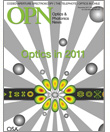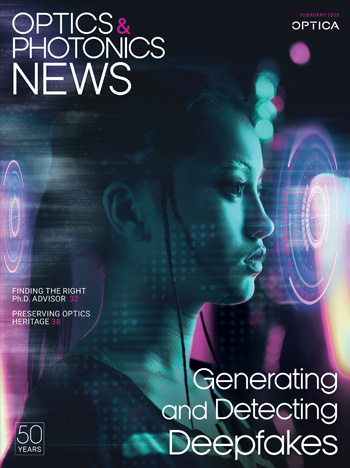
December 2011 Issue
Feature Articles
Optics in 2011
This special issue of OPN highlights the most exciting peer-reviewed optics research to have emerged over the past 12 months.
by Panel Chair: R.D. Guenther; Guest Editors: J. Dawes, C. Lopez-Mariscal, B. Jopson, E. Silaeva and J. ZavislanBio-Optics
The diffusion of light allows biologists to study tissue at various depths below the surface of a person’s skin. One novel development is the construction of a biological laser from a single cell.
Detection
A key component in any optical system is the detector that is used to transform light into a measurement.
Diffraction
Microstructured optical fibers constitute a versatile platform for developing novel optofluidic, sensing and actuating devices—bringing together photonics and microfluidics.
Imaging
Spectral imaging is particularly important in the biosciences. Raman scattering provides unique spectral signatures that can be used in the study of cell chemistry.
Interferometry
A key optical tool for metrology allows us to use a ruler calibrated in wavelengths of light.
Nonlinear Optics
Nonlinear optics allows us to generate sources in new spectral regions and to provide increased signal propagation capability.
Photonic Structures
We have learned how to construct ordered index-of-refraction-modulated structures that allow us to control the propagation of light. Initially, researchers were simply interested in fabrication; now they are exploring limitations in the structures.
Plasmonics
Surface plasmons have the unique capacity to confine light to very small dimensions, but the losses that occur when they propagate have limited their utility.
Quantum Optics
Exciting work is being done in quantum information theory and the detection of low light levels.
Terahertz
The atmosphere is nearly opaque at wavelengths from the far-infrared to the millimeter wave, but there are applications that work around this restriction.
Transformation Optics
A new design concept for optical devices comes from the mathematical view of space-time in general relativity. The desired optical path is determined by coordinate transformations.
Ultrafast Optics
Techniques that use optical pulses extending from the picosecond to the attosecond have become an important adjunct to nanoscale science.
3-D Recording and Display
The display of 3-D objects has always been fascinating. Recent research explores new possibilities in holographic imaging and 3-D television.
Departments and Columns
The University of Arizona’s optics outreach in Chile
A member of the University of Arizona College of Optical Sciences student chapter recently conducted an outreach program to initiate learning and collaborative relationships with scientists, engineers and high school students in Chile.
From Telephote to Television: A Fantastic Journey
Unlike the telephone, the television did not have one clear inventor. It was shaped over decades by the minds of researchers as well as science fiction writers. When it was first conceived and developed, a device that could instantaneously transmit images was referred to as a “telephote.”
The Evolution of Coded-Aperture Spectroscopy
Coded-aperture spectrometers have enabled high-speed applications that were once considered impractical with traditional slit devices. This article traces the history of this type of spectroscopy, from the earliest analog forms to the latest technology.
BiFeO3 Domains May Improve Solar Cells
Scientists describe how unusually high photo-induced voltages are generated in thin films of bismuth ferrite.
Presidential Profile: John Adolph Sanderson
John Adolph Sanderson, OSA’s president in 1967, is remembered for his work on infrared radiation with the U.S. military, his dedication to improving optics education and his great contributions to the Society.
Two-Color STED Helps Unravel Protein Interactions
An advance in superresolution imaging will give scientists the ability to observe how proteins and other molecules interact in living cells in near real time.
Microscopy without Lenses
A new holographic microscope is inexpensive, compact and lightweight, and can be used for both transmission and reflection imaging with resolutions down to 2 µm.
Blending Beams of Light and Plasma in Real Time
A team based at the University of California, Berkeley,has liberated surface plasmon polaritons from the confines of fixed guiding nanostructures.

![Illustration of a synapse in the brain. [Getty Images]](https://opnmedia.blob.core.windows.net/$web/opn/media/images/articles/2025/0425/departments/202504-cover-web.jpg?ext=.jpg)
![Fiber draped around a hand, demonstrating its flexibility. [Photo by Z. Wang and L. Wei]](https://opnmedia.blob.core.windows.net/$web/opn/media/images/articles/2025/0325/departments/202503-cover-web.jpg?ext=.jpg)
